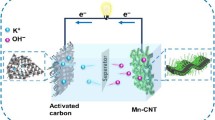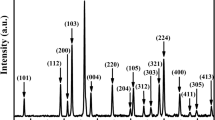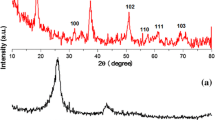Abstract
In this study, we investigate the effectiveness of murexide for surface modification of \(\textrm{Fe}_{3}\textrm{O}_{4}\) nanoparticles to enhance the performance of multiwalled carbon nanotube-\(\textrm{Fe}_{3}\textrm{O}_{4}\) supercapacitor anodes. Our experimental results demonstrate significant improvements in electrode performance when murexide is used as a capping or dispersing agent compared to the case with no additives. When murexide is used as a capping agent, we report a capacitance of 4.2 F cm\(^{-2}\) from cyclic voltammetry analysis with good capacitance retention at high scan rates. From impedance measurements, we reveal a substantial decrease in the real part of impedance for samples prepared with murexide, indicating easier charge transfer at more negative electrode potentials, and reinforcing the role of murexide as a capping agent and charge transfer mediator. Density functional theory is used to investigate interactions between the murexide adsorbate and the \(\textrm{Fe}_{3}\textrm{O}_{4}\) (001) surface, with a specific emphasis on adsorption strength, charge transfer, and electronic properties. This theoretical investigation uncovers a strong adsorption enthalpy of − 4.5 eV and allows us to identify the nature of chemical bonds between murexide and the surface, with significant charge transfer taking place between the \(\textrm{Fe}_{3}\textrm{O}_{4}\) surface and murexide adsorbate. The transfer of electrons from the \(\textrm{Fe}_{3}\textrm{O}_{4}\) surface to murexide is recognized as a vital component of the adsorption process. By examining the bonding nature of murexide on \(\textrm{Fe}_{3}\textrm{O}_{4}\), this research study uncovers insights and proposes a novel bonding configuration of murexide that incorporates a combination of bridging and chelating bonding.
Graphical abstract












Similar content being viewed by others
Data availibility
The raw data (VASP input and structure files) required to reproduce computational findings are available in the Zenodo file repository [48].
References
Olabi AG, Abbas Q, Al Makky A, Abdelkareem MA (2022) Supercapacitors as next generation energy storage devices: properties and applications. Energy 248(123617):123617. https://doi.org/10.1016/j.energy.2022.123617
Forouzandeh P, Kumaravel V, Pillai SC (2020) Electrode materials for supercapacitors: a review of recent advances. Catalysts 10(9):969. https://doi.org/10.3390/catal10090969
Silva RME, Poon R, Milne J, Syed A, Zhitomirsky I (2018) New developments in liquid-liquid extraction, surface modification and agglomerate-free processing of inorganic particles. Adv Colloid Interface Sci 261:15–27. https://doi.org/10.1016/j.cis.2018.09.005
Zhao Q, Wang X, Liu J, Wang H, Zhang Y, Gao J, Liu J, Lu Q (2015) Surface modification and performance enhancement of carbon derived from chromium carbide for supercapacitor applications. J Electrochem Soc 162(6):845–851. https://doi.org/10.1149/2.0331506jes
Pimsawat A, Tangtrakarn A, Pimsawat N, Daengsakul S (2019) Effect of substrate surface roughening on the capacitance and cycling stability of Ni(OH)\(_2\) nanoarray films. Sci Rep 9(1):16877. https://doi.org/10.1038/s41598-019-53365-1
Yang LW, Zhitomirsky I (2023) Influence of capping agents on the synthesis of Mn\(_{3}\)O\(_{4}\) nanostructures for supercapacitors. ACS Appl Nano Mater 6(6):4428–4436. https://doi.org/10.1021/acsanm.2c05519
Chen W, Rakhi RB, Hu L, Xie X, Cui Y, Alshareef HN (2011) High-performance nanostructured supercapacitors on a sponge. Nano Lett 11(12):5165–5172. https://doi.org/10.1021/nl2023433
Shao Y, El-Kady MF, Sun J, Li Y, Zhang Q, Zhu M, Wang H, Dunn B, Kaner RB (2018) Design and mechanisms of asymmetric supercapacitors. Chem Rev 118(18):9233–9280. https://doi.org/10.1021/acs.chemrev.8b00252
Brousse T, Bélanger D (2003) A hybrid Fe\(_3\)O\(_4\)-MnO\(_2\) capacitor in mild aqueous electrolyte. Electrochem Solid State Lett 6(11):A244–A248. https://doi.org/10.1149/1.1614451
Gogotsi Y, Simon P (2011) True performance metrics in electrochemical energy storage. Science 334(6058):917–918. https://doi.org/10.1126/science.1213003
Ata MS, Liu Y, Zhitomirsky I (2014) A review of new methods of surface chemical modification, dispersion and electrophoretic deposition of metal oxide particles. RSC Adv 4(43):22716–22732. https://doi.org/10.1039/C4RA02218A
Yang W, Nawwar M, Zhitomirsky I (2022) Facile route for fabrication of ferrimagnetic Mn\(_3\)O\(_4\) spinel material for supercapacitors with enhanced capacitance. Energies 15(5):1812. https://doi.org/10.3390/en15051812
Ata MS, Zhitomirsky I (2012) Electrophoretic nanotechnology of ceramic films. Adv Appl Ceram 111(5–6):345–350. https://doi.org/10.1179/1743676111y.0000000070
Gulley-Stahl H, Hogan PA, Schmidt WL, Wall SJ, Buhrlage A, Bullen HA (2010) Surface complexation of catechol to metal oxides: an ATR-FTIR, adsorption, and dissolution study. Environ Sci Technol 44(11):4116–4121. https://doi.org/10.1021/es902040u
Liu Y, Zhitomirsky I (2014) Aqueous electrostatic dispersion and heterocoagulation of multiwalled carbon nanotubes and manganese dioxide for the fabrication of supercapacitor electrodes and devices. RSC Adv 4(85):45481–45489. https://doi.org/10.1039/c4ra05879h
Saiz-Poseu J, Mancebo-Aracil J, Nador F, Busqué F, Ruiz-Molina D (2018) The chemistry behind catechol-based adhesion. Angew Chem Int Ed 58(3):696–714. https://doi.org/10.1002/anie.201801063
Sakib S, Bakhshandeh F, Saha S, Soleymani L, Zhitomirsky I (2021) Surface functionalization of metal oxide semiconductors with catechol ligands for enhancing their photoactivity. Sol RRL 5(10):2100512. https://doi.org/10.1002/solr.202100512
Nawwar M, Poon R, Sahu RP, Puri IK, Zhitomirsky I (2020) Fe\(_3\)O\(_4\) spinel-Mn\(_3\)O\(_4\) spinel supercapacitor prepared using celestine blue as a dispersant, capping agent and charge transfer mediator. Ceram Int 46(11):18851–18858. https://doi.org/10.1016/j.ceramint.2020.04.204
Yu H, Wu J, Fan L, Hao S, Lin J, Huang M (2014) An efficient redox-mediated organic electrolyte for high-energy supercapacitor. J Power Sources 248:1123–1126. https://doi.org/10.1016/j.jpowsour.2013.10.040
Yin Y, Zhou J, Mansour AN, Zhou X (2011) Effect of NaI/I\(_2\) mediators on properties of PEO/LiAlO\(_2\) based all-solid-state supercapacitors. J Power Sources 196(14):5997–6002. https://doi.org/10.1016/j.jpowsour.2011.02.079
Akinwolemiwa B, Peng C, Chen GZ (2015) Redox electrolytes in supercapacitors. J Electrochem Soc 162(5):5054–5059. https://doi.org/10.1149/2.0111505jes
Tamirat AG, Guan X, Liu J, Luo J, Xia Y (2020) Redox mediators as charge agents for changing electrochemical reactions. Chem Soc Rev 49(20):7454–7478. https://doi.org/10.1039/D0CS00489H
Roldán S, Blanco C, Granda M, Menéndez R, Santamaría R (2011) Towards a further generation of high-energy carbon-based capacitors by using redox-active electrolytes. Angew Chem Int Ed Engl 50(7):1699–1701. https://doi.org/10.1002/anie.201006811
Kashanian S, Gholivand MB, Madaeni S, Nikrahi A, Shamsipur M (1988) Spectrophotometric study of the complexation reactions between alkaline earth cations and murexide in some non-aqueous solutions. Polyhedron 7(14):1227–1230. https://doi.org/10.1016/S0277-5387(00)81216-4
Shamsipur M, Esmaeili A, Amini MK (1989) Formation of cobalt, nickel and copper complexes with murexide in ethanol-water mixtures. Talanta 36(12):1300–1302. https://doi.org/10.1016/0039-9140(89)80067-0
Shamsipur M, Madaeni S, Kashanian S (1989) Spectrophotometric study of the alkali metal-murexide complexes in some non-aqueous solutions. Talanta 36(7):773–776. https://doi.org/10.1016/0039-9140(89)80147-x
Parham H, Shamsipur M (1992) Spectrophotometric study of some alkali and alkaline earth cryptates in dimethylformamide solution using murexide as a metallochromic indicator. Polyhedron 11(8):987–991. https://doi.org/10.1016/S0277-5387(00)83352-5
Masoud MS, Kassem TS, Shaker MA, Ali AE (2006) Studies on transition metal murexide complexes. J Therm Anal Calorim 84(3):549–555. https://doi.org/10.1007/s10973-005-9991-3
Mohran HS (2009) An electrochemical investigation of the redox properties of murexide in aqueous and non-aqueous media. Am J Appl Sci 6(5):964–969. https://doi.org/10.3844/ajassp.2009.964.969
Serwar M, Rana UA, Siddiqi HM, Ud-Din Khan S, Ahmed Ali FA, Al-Fatesh A, Adomkevicius A, Coca-Clemente JA, Cabo-Fernandez L, Braga F, Hardwick LJ (2017) Template-free synthesis of nitrogen doped carbon materials from an organic ionic dye (murexide) for supercapacitor application. RSC Adv 7:54626–54637. https://doi.org/10.1039/C7RA10954G
Atay NZ, Varnali T (2002) A semi-empirical study on metal ion/murexide complexation. Turk J Chem 26:303–310
Nawwar M, Poon R, Chen R, Sahu RP, Puri IK, Zhitomirsky I (2019) High areal capacitance of Fe\(_3\)O\(_4\)-decorated carbon nanotubes for supercapacitor electrodes. Carbon Energy 1(1):124–133. https://doi.org/10.1002/cey2.6
Shi K, Zhitomirsky I (2013) Electrophoretic nanotechnology of graphene-carbon nanotube and graphene-polypyrrole nanofiber composites for electrochemical supercapacitors. J Colloid Interface Sci 407:474–481. https://doi.org/10.1016/j.jmat.2018.02.004
Zhu Y, Shi K, Zhitomirsky I (2014) Polypyrrole coated carbon nanotubes for supercapacitor devices with enhanced electrochemical performance. J Power Sources 268:233–239. https://doi.org/10.1021/acsomega.9b04029
Kohn W, Sham LJ (1965) Self-consistent equations including exchange and correlation effects. Phys Rev 140(4A):1133–1138. https://doi.org/10.1103/PhysRev.140.A1133
Perdew JP, Burke K, Ernzerhof M (1996) Generalized gradient approximation made simple. Phys Rev Lett 77(18):3865–3868. https://doi.org/10.1103/PhysRevLett.77.3865
Grimme S, Ehrlich S, Goerigk L (2011) Effect of the damping function in dispersion corrected density functional theory. J Comput Chem 32(7):1456–1465. https://doi.org/10.1002/jcc.21759
Grimme S, Antony J, Ehrlich S, Krieg H (2010) A consistent and accurate ab initio parametrization of density functional dispersion correction (DFT-D) for the 94 elements H-Pu. J Chem Phys 132(15):154104. https://doi.org/10.1063/1.3382344
Kresse G, Hafner J (1993) Ab initio molecular dynamics for liquid metals. Phys Rev B 47(1):558–561. https://doi.org/10.1103/PhysRevB.47.558
Kresse G, Furthmüller J (1996) Efficiency of ab-initio total energy calculations for metals and semiconductors using a plane-wave basis set. Comput Mater Sci 6(1):15–50. https://doi.org/10.1016/0927-0256(96)00008-0
Kresse G, Furthmüller J (1996) Efficient iterative schemes for ab initio total-energy calculations using a plane-wave basis set. Phys Rev B 54(16):11169–11186. https://doi.org/10.1103/PhysRevB.54.11169
Kresse G, Joubert D (1999) From ultrasoft pseudopotentials to the projector augmented-wave method. Phys Rev B 59(3):1758–1775. https://doi.org/10.1103/PhysRevB.59.1758
Dudarev SL, Botton GA, Savrasov SY, Humphreys CJ, Sutton AP (1998) Electron-energy-loss spectra and the structural stability of nickel oxide: an LSDA+U study. Phys Rev B 57(3):1505–1509. https://doi.org/10.1103/PhysRevB.57.1505
Bliem R, Pavelec J, Gamba O, McDermott E, Wang Z, Gerhold S, Wagner M, Osiecki J, Schulte K, Schmid M, Blaha P, Diebold U, Parkinson GS (2015) Adsorption and incorporation of transition metals at the magnetite Fe\(_3\)O\(_4\) (001) surface. Phys Rev B 92(7):075440. https://doi.org/10.1103/PhysRevB.92.075440
Chiter F, Nguyen VB, Tarrat N, Benoit M, Tang H, Lacaze-Dufaure C (2016) Effect of van der Waals corrections on DFT-computed metallic surface properties. Mater Res Express 3(4):046501. https://doi.org/10.1088/2053-1591/3/4/046501
Henkelman G, Arnaldsson A, Jónsson H (2006) A fast and robust algorithm for Bader decomposition of charge density. Comput Mater Sci 36(3):354–360. https://doi.org/10.1016/j.commatsci.2005.04.010
Wang V, Xu N, Liu J-C, Tang G, Geng W-T (2021) VASPKIT: a user-friendly interface facilitating high-throughput computing and analysis using VASP code. Comput Phys Commun 267:108033. https://doi.org/10.1016/j.cpc.2021.108033
Boucher C, Zhitomirsky I, Rubel O (2023) Application of murexide as a capping agent for fabrication of magnetite anodes for supercapacitors: experimental and first-principle studies (computational workflows). Zenodo. https://doi.org/10.5281/zenodo.8183854
Momma K, Izumi F (2011) VESTA 3 for three-dimensional visualization of crystal, volumetric and morphology data. J Appl Crystallogr 44(6):1272–1276. https://doi.org/10.1107/S0021889811038970
Pell WG, Conway BE (2001) Analysis of power limitations at porous supercapacitor electrodes under cyclic voltammetry modulation and dc charge. J Power Sources 96(1):57–67. https://doi.org/10.1016/S0378-7753(00)00682-0
Chowdhury A, Biswas S, Singh T, Chandra A (2022) Redox mediator induced electrochemical reactions at the electrode-electrolyte interface: making sodium-ion supercapacitors a competitive technology. Electrochem Sci Adv 2(1):2100030. https://doi.org/10.1002/elsa.202100030
Gharbi O, Tran MTT, Tribollet B, Turmine M, Vivier V (2020) Revisiting cyclic voltammetry and electrochemical impedance spectroscopy analysis for capacitance measurements. Electrochim Acta 343(136109):136109. https://doi.org/10.1016/j.electacta.2020.136109
Augustyn V, Simon P, Dunn B (2014) Pseudocapacitive oxide materials for high-rate electrochemical energy storage. Energy Environ Sci 7(5):1597–1614. https://doi.org/10.1039/C3EE44164D
Boucher C, Rubel O, Zhitomirsky I (2023) Supercapacitor performance of magnetite nanoparticles enhanced by a catecholate dispersant: experiment and theory. Molecules 28(4):1562. https://doi.org/10.3390/molecules28041562
Bliem R, McDermott E, Ferstl P, Setvin M, Gamba O, Pavelec J, Schneider MA, Schmid M, Diebold U, Blaha P, Hammer L, Parkinson GS (2014) Subsurface cation vacancy stabilization of the magnetite (001) surface. Science 346(6214):1215–1218. https://doi.org/10.1126/science.1260556
Gargallo-Caballero R, Martín-García L, Quesada A, Granados-Miralles C, Foerster M, Aballe L, Bliem R, Parkinson GS, Blaha P, Marco JF, Figuera J (2016) Co on Fe\(_3\)O\(_4\) (001): towards precise control of surface properties. J Chem Phys 144(9):094704. https://doi.org/10.1063/1.4942662
Bader RFW (1990) Atoms in molecules: a quantum theory. Oxford University Press, New York
Rojas-Cuervo AM, Rey-González RR (2023) Electronic band gap on graphene induced by interaction with hydrogen cyanide. An DFT analysis. Chem Phys 565:111744. https://doi.org/10.1016/j.chemphys.2022.111744
Zhang Y, Song Z, Miao L, Lv Y, Gan L, Liu M (2023) All-round enhancement in Zn-ion storage enabled by solvent-guided Lewis acid-base self-assembly of heterodiatomic carbon nanotubes. ACS Appl Mater Interfaces 15(29):35380–35390. https://doi.org/10.1021/acsami.3c06849
Qin Y, Song Z, Miao L, Hu C, Chen Y, Liu P, Lv Y, Gan L, Liu M (2023) Hydrogen-bond-mediated micelle aggregating self-assembly towards carbon nanofiber networks for high-energy and long-life zinc ion capacitors. Chem Eng J 470:144256. https://doi.org/10.1016/j.cej.2023.144256
Song Z, Miao L, Lv Y, Gan L, Liu M (2023) NH\(_4^+\) charge carrier coordinated H-bonded organic small molecule for fast and superstable rechargeable zinc batteries. Angew Chem Int Ed 135(38):e202309446. https://doi.org/10.1002/ange.202309446
Moradi L, Tadayon M (2018) Green synthesis of 3,4-dihydropyrimidinones using nano Fe\(_3\)O\(_4\)@meglumine sulfonic acid as a new efficient solid acid catalyst under microwave irradiation. J Saudi Chem Soc 22(1):66–75. https://doi.org/10.1016/j.jscs.2017.07.004
Janković IA, Šponjić ZV, Čmor MI, Nedeljković JM (2009) Surface modification of colloidal TiO\(_2\) nanoparticles with bidentate benzene derivatives. J Phys Chem C 113(29):12645–12652. https://doi.org/10.1021/jp9013338
Maity JP, Kar S, Lin C-M, Chen C-Y, Chang Y-F, Jean J-S, Kulp TR (2013) Identification and discrimination of bacteria using Fourier transform infrared spectroscopy. Spectrochim Acta Part A 116:478–484. https://doi.org/10.1016/j.saa.2013.07.062
Dhahri R, Guizani M, Yılmaz M, Mechi L, Dhahi Alsukaibi AK, Alimi F, ben Salem R, Moussaoui Y (2022) Experimental design analysis of murexide dye removal by carbon produced from waste biomass material. J Chem 2022:9735071. https://doi.org/10.1155/2022/9735071
Aliahmad M, Nasiri Moghaddam N (2013) Synthesis of maghemite (\(\gamma \)-Fe\(_2\)O\(_3\)) nanoparticles by thermal-decomposition of magnetite (Fe\(_3\)O\(_4\)) nanoparticles. Mater Sci Pol 31(2):264–268. https://doi.org/10.2478/s13536-012-0100-6
Acknowledgements
This research was funded by the Natural Sciences and Engineering Research Council of Canada, grant number RGPIN-2018-04014, and Faculty of Engineering of McMaster University. Calculations were performed using the Compute Canada infrastructure supported by the Canada Foundation for Innovation under John R. Evans Leaders Fund.
Author information
Authors and Affiliations
Contributions
Conceptualization was prepared by I.Z. and C.B.; carrying out experiments and calculations and writing original draft were done by C.B. and D.T.; data analysis and interpretation were revised by C.B., D.T., I.Z., and O.R.; manuscript review and editing were analyzed by I.Z. and O.R.
Corresponding author
Ethics declarations
Conflict of interest
There are no conflicts of interest exist.
Additional information
Handling Editor: Kevin Jones.
Publisher's Note
Springer Nature remains neutral with regard to jurisdictional claims in published maps and institutional affiliations.
Supplementary Information
Below is the link to the electronic supplementary material.
Rights and permissions
Springer Nature or its licensor (e.g. a society or other partner) holds exclusive rights to this article under a publishing agreement with the author(s) or other rightsholder(s); author self-archiving of the accepted manuscript version of this article is solely governed by the terms of such publishing agreement and applicable law.
About this article
Cite this article
Boucher, C., Tang, D., Zhitomirsky, I. et al. Application of murexide as a capping agent for fabrication of magnetite anodes for supercapacitors: experimental and first-principle studies. J Mater Sci 59, 5480–5497 (2024). https://doi.org/10.1007/s10853-024-09524-5
Received:
Accepted:
Published:
Issue Date:
DOI: https://doi.org/10.1007/s10853-024-09524-5




